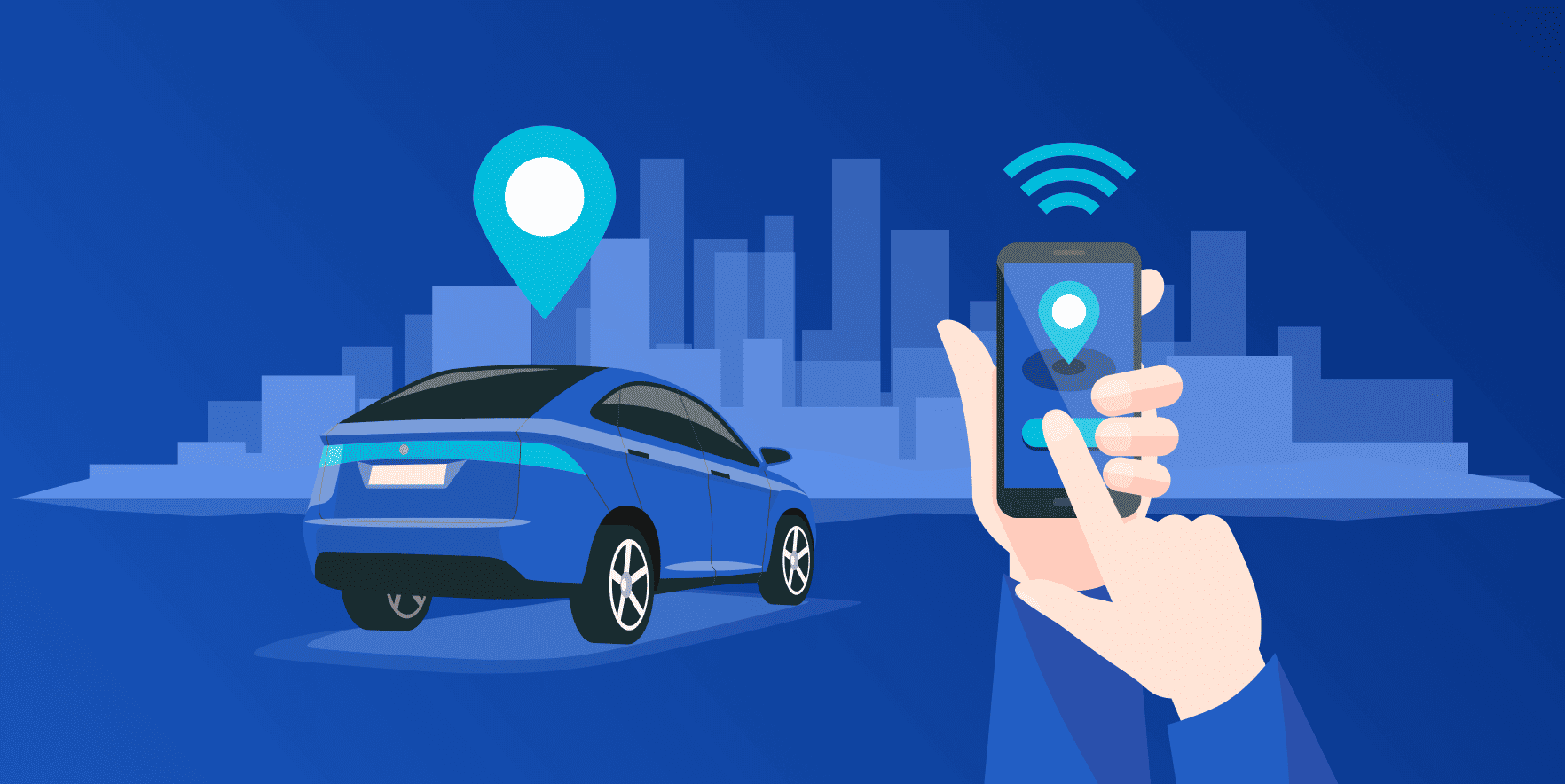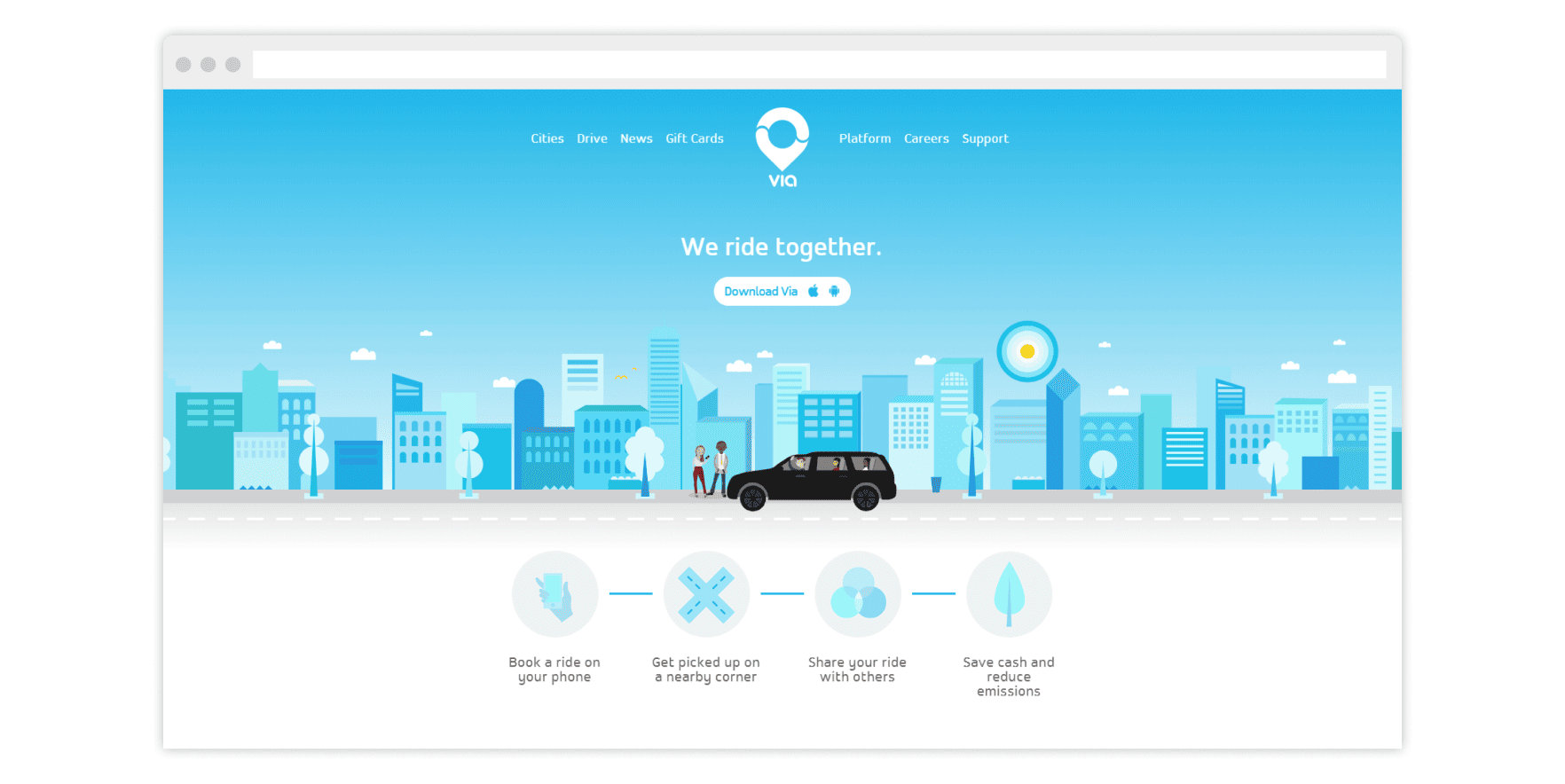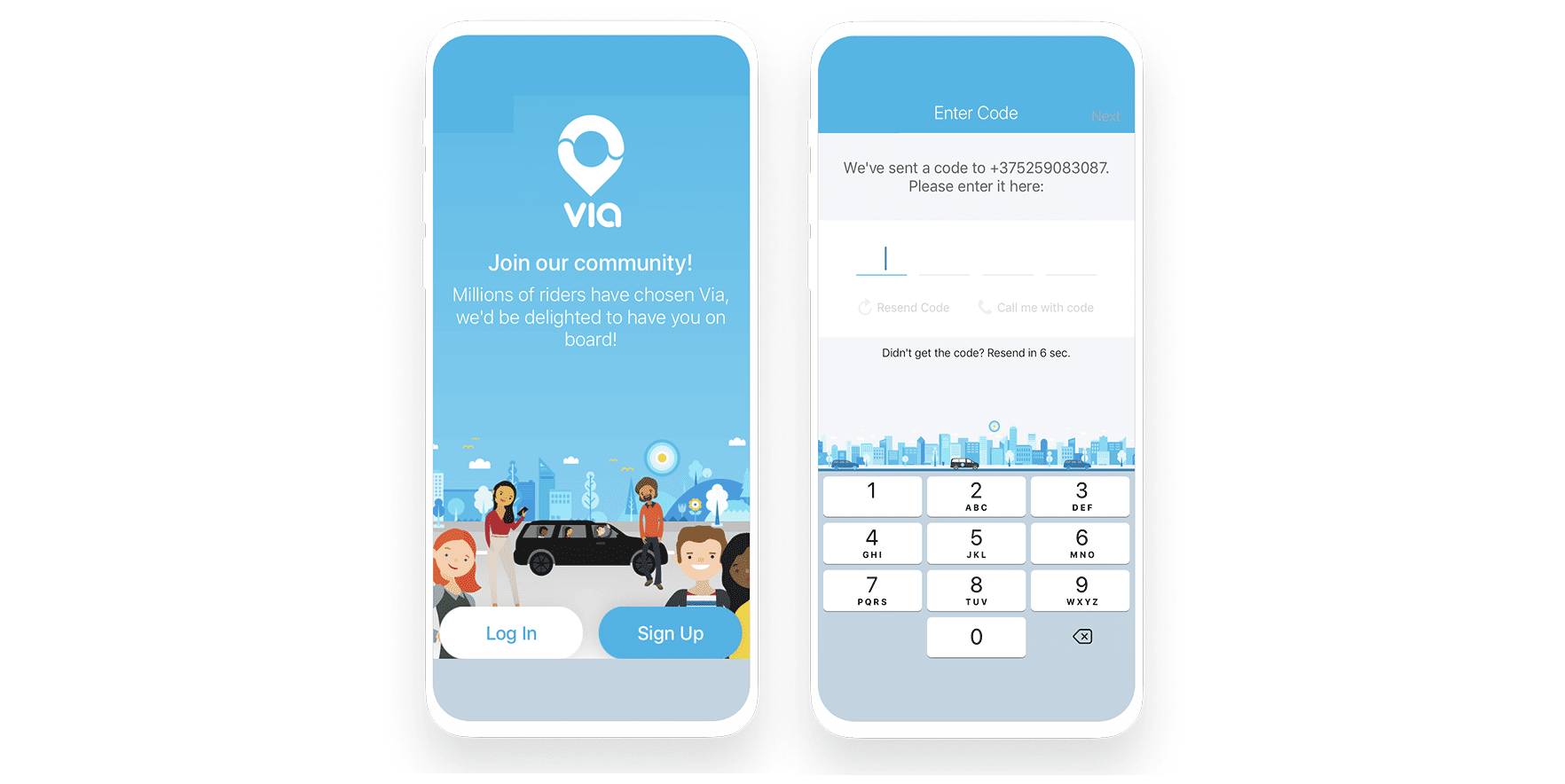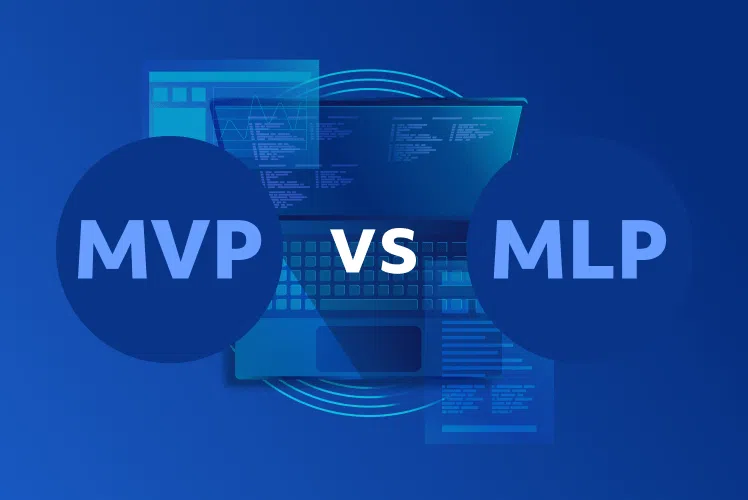Table of Contents
As Business Research predicts, the ride-sharing market will probably reach the volume of $157.02 billion in 2025, proving its stable and consistent growth throughout the years. These numbers clearly indicate that ride-sharing apps are in high demand and will remain so in the near future. That being said, now is the best time to invest in a high-performing application but the question is how to create a rideshare app that will bring value both to users and drivers?
In this guide, we will walk you through the specifics of the ride sharing app development and will discuss its potential cost, must-have features, and main things to consider.

The rise of ride-sharing apps: an overview of the market
Before diving deeper into the topic of app development, it is important to review the current state of the ride-sharing market and the biggest players out there so let’s get started.
The continuing popularity of ride-sharing can be explained by the ultimate benefits these apps bring and the way they transform urban mobility. Users can get a car in a few taps and get to their destination for a convenient price while drivers receive pretty good earnings and can organize their own schedule. Hence, it comes as no surprise that new ride-sharing apps emerge on a regular basis despite brands Uber, Lyft, or Via remain strong in their positions.
Here are some more numbers from Business Research on the current and expected state of the ride-sharing market:
- The expected CAGR for the period 2024-2025 is 19%;
- The expected market volume for 2029 is approximately $341.1 billion.
The statistics clearly show that the market is now experiencing high popularity and users across the globe actively use ride-hailing and ride-sharing services.
Ride-hailing vs ride-sharing
It is also important to differentiate between the two similar terms: ride-hailing and ride-sharing. Ride-hailing is the process of hiring a personal driver for a single person. The best example is Uber when a user simply requests a drive and does not share it with anyone.
Ride-sharing, on the other hand, is a more sustainable option when one ride is shared with several people. In this way, a car makes several stops and the cost is usually more affordable than for ride-hailing services.
In general, both services are very similar and the only difference is in the number of riders. Now let’s move on to discussing the main features of a user-centric ride-sharing app.
Key features of a ride-sharing app
A ride-sharing app consists of three main components: apps for passengers, drivers and administrators. Each app will have its distinct features and thus should be discussed separately.
Passenger app
A passenger (rider) app is used by those that wish to request a ride-sharing service and pay for it. While these apps are quite simplistic on the first glance, they normally include several critical features that create a holistic and satisfying user experience:
Registration and profile creation: this is an essential feature for any mobile application as it allows users to see the history of their activities, store important information (such as payment data), and manage their profile settings. In ride-sharing apps, user profiles usually display one’s personal data, the history of rides, and preferred payment methods as well as user ratings.
Note that the app should offer various registration methods, including sign up via a social network of choice. This will significantly speed up the registration process and will encourage users to complete it.
Notifications: inform users in real time about accepted, upcoming, or cancelled rides and sends important information like messages from drivers. Notifications are a must-have feature of any ride-sharing application as they help both drivers and riders manage their time and plan the trip correspondingly.
Geolocation and routing: passengers need to have access to an integrated map to select the needed destination and correctly mark their location for the pickup. As well, many passengers prefer monitoring their ride and its current location in real time, which is why geolocation and routing are a must.
Payment options: a successful ride-sharing app typically offers several payment methods for the convenience of its users. Passengers should also be able to change the payment method settings, easily switch between credit card and cash payments, and tip the drivers.
Messages & calls: this feature helps passengers and drivers communicate either via text messages or calls. Riders often call drivers (and vice versa) to clarify the exact location of the pickup so it’s important that both parties can get in touch via the app.
Driver app
The driver’s part of a ride-sharing app helps drivers track and accept requests and manage their earnings. Though the functionality of driver and passenger apps is similar, there are also some differences. The core functions of a driver app include:
Profile and registration: same as for the passenger app but should also include a driver’s license number and other important information related to his work (i.e., might be compliance with local regulations).
Request management: this option allows drivers to manage requests such as accepting or declining them as well as viewing.
Trip data: the app should display information about the upcoming trip, such as precise pickup location, information about the passenger, and expected duration of the trip. This feature is important so the drivers can effectively manage their workfload throughout the day.
Geolocation and routing: same as for passengers, this feature is critical for drivers as it lets them navigate, correctly identify pickup locations, and create faster and more secure routes.
Payment receival: drivers should be able to monitor their income, access payment history, and receive payments and tips.
Notifications & messaging: this feature helps notify drivers about important information (like an upcoming pickup) and get in touch with the riders via the preferred communication method.
Admin app
An admin app is usually a web portal that enables drivers to register for work and allows administrators to monitor their work, resolve issues, and manage the overall workflow. In Via, for example, there is a separate online portal that provides easy enrollment for drivers and stores important information such as drivers’ personal data and licenses. You can tweak the admin panel exactly how you need: make it a customer support hub, a drivers’ hub, or merge several functions into a single solution.
Examples of features that an admin app might have:
- Customer service and 24/7 support
- Tracking of rides and of drivers’ activity
- Enrollment process for drivers
- Payment management system and accounting
How to create a rideshare app: a step-by-step guide
Considering the high demand for ride-sharing apps and the high competition in the market, it is critical to deliver a secure and highly functional product to end users. Below we list the essential steps of the app development process that help ensure that nothing is missed.
Research the market and competition
When you want to create your own rideshare app, you naturally expect it to bring value to both passengers and drivers, so it is important to understand the market, the current needs and wants of both user groups, and the current competition. The competitor analysis is highly important as it allows businesses to understand what the competitors do wrong and what they do right. In this way, app developers can avoid the most common mistakes while bringing something new and innovative to the market.
If you partner with an IT outsourcing company, note that market and competition research is often performed together with the business analyst from the company. SInce IT providers usually have rich experience in specific industries, they can often propose the most suitable solutions and approaches.
Definition of the app functionality and user flow
The next step after the market research is the definition of the app’s functionality and user flows aka steps that a user will take to achieve the needed goal. You want your app to be valuable, user-centric, and intuitive in terms of navigation. For that, it is important to outline user journeys, perform A/B testing, and eliminate roadblocks before starting work on the UX/UI design.
As for the functionality, we recommend listing down all the features that you’d like to include in the app and prioritize them. As a result, you will have must-have, nice to have, and extra features. This will serve as a base for further development process and will help you save time and finances as you won’t invest in unnecessary functionality from the start.
Pro tip: we recommend first starting with the MVP development to test your app’s idea and collect feedback from real users before officially releasing a full-fledged app version.
Tech stack selection
The next step in rideshare app development is the selection of the suitable tech stack that will serve as the base for ride sharing software. The choice of technologies to use in the project will depend on multiple factors such as the desired features, the size and scalability of the app, its architecture, the selected platform, etc. Note that there are certain technologies that work the best as a set such as MERN stack, consisting of MongoDB, Express.js, React, and Node.js. These four technologies work together seamlessly and support each other’s functionality, hence forming the MERN stack and being recommended to use together. If you work with an IT provider, the company will advise you on the best technology selection since they will also be involved in the project analysis and will have a clear understanding of what exactly you need.
Product architecture and UX/UI design
When working on architecture and design of your app, remember two core things: scalability and focus on the user. The design of a ride-sharing app should be simplistic and intuitive, without any feature overload. If hesitant, either conduct A/B testing or use the design of your biggest competitors as inspiration. As for the architecture, it should support the growing volume of user and should allow you to expand the app’s functionality in the future (if needed).
Development and testing
During this stage, you will be creating the app’s functionality so it’s critical to ensure that developers are proficient in the design of similar applications. Also, try sticking to the initial list of features that you approved at the beginning of taxi app development process. Otherwise, it’s easy to fall into scope creep, where unapproved of unexpected features appear constantly, thus expanding the project scope in an uncontrollable manner. Remember we recommended starting with the MVP? This will be your starting point to deliver a fully functional yet minimalistic product.
Also, don’t forget about continuous testing, meaning you will be testing the app throughout its development. This approach minimizes the number of bugs and issues before the release and ensures that any new feature won’t disrupt the functioning of the product.
Launch and marketing
Once everything is tested, the app is ready for launch – but work does not end here. After the release, the development team closely monitors the app in order to timely react to unexpected glitches and errors. As well, the team can add extra functionality or tweak the existing one based on the user feedback, which is also important for the app’s success.
And don’t forget about marketing which should take place before, during and after the app release. Since the ride-sharing market is highly competitive, you want to make sure that users know about your app in advance and are willing to try it.
The cost & duration of ride-sharing app development
Now, the big question is how much does it cost to create a ride-sharing application and how long does it take?
There is no definite answer to this question as the final cost will heavily depend on the following factors:
- Development method: in-house development or outsourcing. Overall, IT outsourcing is more cost-effective than in-house development so we highly recommend this approach.
- Selected platform(s): will your app be native (iOS, Android) or cross-platform? The choice of the platform will impact the cost of taxi application development, with native development being more expensive than cross-platform.
- Team size: depending on the app’s complexity, your development team will consist of several software engineers, QA engineers, a business analyst, a Project Manager, and a UX/UI designer. You might also involve copywriters and SEO specialists for app promotion online and for creation of in-app content.
- Design complexity: a design that is too complex has several advantages. First, it costs much more than the simplistic one and second, the overload of elements will confuse users. Hence, we recommend going for minimalistic and user-centered design.
- Functionality: the cost of an app directly depends on the complexity of its functionality as the addition of any new features will increase the costs.
- Integrations: same as functionality, the number of integrations also impacts the final cost of the app so we recommend starting with essential ones first.
- Licensing: you might need to pay for software licensing so make sure to discuss this with the development team before starting work on the project.
- Support and maintenance: the price and terms for the app support and maintenance is discussed individually with the IT provider.
The average cost of developing a ride-sharing app is approximately $30,000 – $50,000 and the average duration is between 4-7 months.
Monetization models for a ride-sharing app
Another important issue to discuss is the way you will monetize your app. There are several models to choose from – let’s briefly review each below:
Commission fees
The most common monetization model, used by such ride-sharing behemoths like Uber or Lyft, implies charging a certain service fee from every transaction. That means that a certain percentage of the ride cost goes to the app owner and the driver receives the rest. Note though that the service fee can be charged from either the driver, the passenger, or even both.
Advertisement & partnership
Advertisement has always been a popular way of monetization but is less popular in ride-sharing apps – here is why. Ads tend to irritate users and slow down their user journey or distract them from the conversion. So while certain apps actively user ads (i.e., games), in ride-sharing apps it is more common to use collaborations with relevant brands, like Lyft did with BMW.
The use of advanced technologies in ride-sharing software
Remember we talked about the importance of standing out from the competition in order to gain users and become successful in the market? One of the ways to do so is implementing advanced technologies in your ride-sharing app. Technologies like IoT and Artificial Intelligence can not only add an extra layer of functionality but also greatly improve user experience through speed and efficiency of services. Here are the top examples of how technology benefits ride-sharing:
AI and machine learning
Artificial Intelligence and machine learning are used in a variety of industries due to the ability of these technologies to quickly process massive data sets and building accurate forecasts based on the data. In ride-sharing, AI and ML can help with the following:
- Demand forecasting: ride-sharing apps use dynamic pricing which means prices for the ride are adjusted with the demand for them and the availability of drivers. AI can help forecast when the demand will be high, moderate, and low, and therefore can assist in better adjustment of prices.
- Route optimization: one more important use case for AI in ride-sharing is route optimization via the analysis of historical data and real-time traffic conditions. By analyzing this data, AI-powered systems can propose the safest and shortest routes, thus minimizing spent time and fuel.
- Customer service: ride-sharing apps can incorporate smart bots to speed up the customer service process and provide 24/7 support.
Internet of Things
Another important technology for the ride-sharing industry is Internet of Things. IoT helps business owners better manage their fleets through remote monitoring via smart sensors. By always knowing the exact location of vehicles, owners can allocate them in a smarter manner. IoT also helps with predictive maintenance and immediate response to any malfunctions. Since smart sensors can monitor vibration, tire pressure, and other important indicators, they play a great role in notifying business owners about any deviation from the standard. And powered with ML, IoT sensors can help predict upcoming maintenance or failures.
Case study from SoftTeco: Via
SoftTeco has played a big role in developing Via – one of the leading ride-sharing apps. Our team joined the project back in 2014 and since then has been assisting the in-house team with functionality improvements and enhancements.

Via is a sustainable ride-sharing app that allows users to share rides with other passengers. The product consists of several parts: a driver application, a passenger application, a registration portal for drivers, and a business portal for effective work with Via partners. When SoftTeco first joined the team, our main responsibility was the development of the registration portal and later, we became involved in other sub-projects such as Activities, Referrals, and CashOut portals.
Among Via’s key features are extensive integrations with Salesforce, flexible rules management, and integrations with several external services such as DocuSign and CheckR. SoftTeco continues working on the app together with the in-house team and provides 24/7 technical support.

Final word
Ride-sharing app development is a highly beneficial niche to enter but there are several hidden rocks to consider before beginning the development process. First, it is important to thoroughly analyze your current local market and come up with a solution that will bring real value to users. Second, it is highly recommended to partner with an experienced app development company like SoftTeco that will not only guide you through the development process but will also take care of all technical aspects, thus enabling you to focus on marketing and promotion. If you still have any questions left about the nuances of creating a stellar ride-sharing app, don’t hesitate to contact us – our team will gladly help you.


Comments